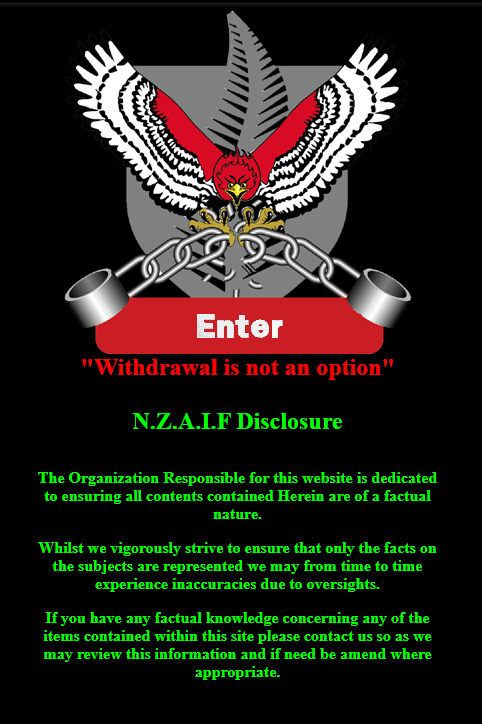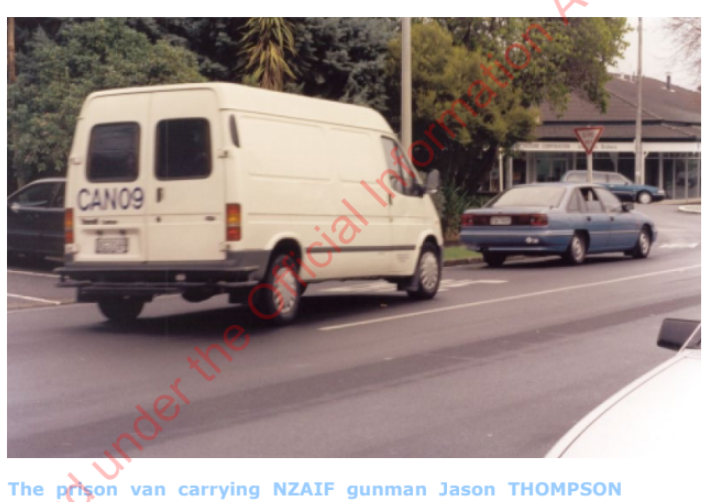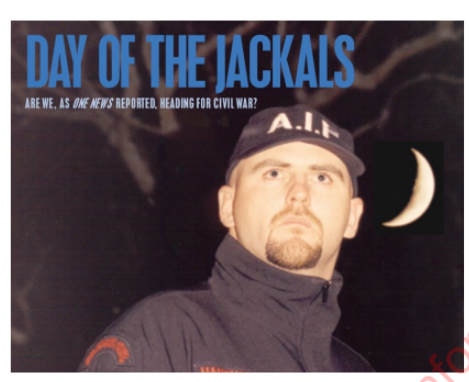Excerpt from the 2000 magazine article/interview.
Source: DIA OIA Release -relates to Investigate Magazine article 2000
Source: DIA OIA Release
Image Source: Stuff, Fire n Fury
Unpacking the Militia Myth: The New Zealand Armed Intervention Force (NZAIF)
The New Zealand Armed Intervention Force (NZAIF) holds an outsized place in the history of anti-government entities in New Zealand. Fronted by Kelvyn Alp (hereafter KA) in 1996, shortly after his brief (c.one year) tenure as a New Zealand Army Recruit, the NZAIF claimed to be the “legally recognised Armed Force” of the [pseudo] Māori Government of Aotearoa. Its website asserted that the group operated with “complete lawfulness and legality” while pre-emptively rejecting characterisations of “extremist” or “terrorist”. Despite this it suggested that “civil war” with the state remained possible (“if it was requested to do so”). KA later claimed that the ‘unit’s formation stemmed from requests by unnamed individuals tracking his “military progress” and who believed he had the "psychological profile" they required. In later years he would say he was approached after “leaving the military in less than favourable circumstances”.
From its inception, the NZAIF’s relied heavily on military aesthetics and language to cultivate legitimacy. KA styled himself as “Raven 1”, with the rank of ‘Lieutenant Commander’ and advocated for the abolition of taxes, supported a sovereign currency, and the restoration of ‘sovereignty to the people’. The website castigated NZ Police as misled and corrupt, claiming it was their duty…”to arrest the colonial government”. It denounced the financial system - "We can no longer sustain a “Debt Money' system”, arguing that the government should cease borrowing from private banking corporations and issue “its own coin, credit and currency”.
Financial credibility was tenuous. KA asserted he had personally invested tens of thousands of dollars into NZAIF, supplemented by alleged earnings of members working as overseas mercenaries. In February 2000, KA placed advertisements in the New Zealand Herald seeking recruits, particularly those with military service. He claimed his initial intake of 12 had undertaken overseas combat against a elite ‘GI Joe outfit’, and ‘special ops’ with one fatality though no obituary or documentation substantiated these claims. The inherent opacity of legitimate operations creates fertile ground for figures to myth-make and embellish personas.
The NZAIF’s public profile peaked in July 2000, Jason Thompson (aged 26) appeared in court after firearms were found in his vehicle during a traffic stop. Representing himself, Thompson claimed that he had just finished NZAIF training and was engaged in “diplomatic exercises”, purportedly sanctioned by the [pseudo] Confederation of Chiefs of the United Tribes of Aotearoa.(CCUTA). This claim was legally baseless, and his small group of supporters disrupted proceedings by refusing to follow court room protocol, prompting their exit. Thompson, who had no fixed abode, was remanded to custody until July 20. During the hearing, he was flanked by armed police to mitigate any potential NZAIF interference.
KA attended wearing black, with an earpiece and a microphone which he claimed were necessary for communication with unseen ‘others’. To the media, he described Thompson as a “political prisoner”, and proclaimed that the NZAIF were allowed to carry weapons (though he himself was unarmed), that live ammunition was used for training, and that the group was “100 strong” , a figure that was never independently corroborated. He further alleged that the NZAIF had considered freeing Thompson from prison but refrained upon the advice of the ‘Maori Government’. KA portrayed NZAIF as being a disciplined but domestically restrained force, presenting the motto, “withdraw is not a option”, as evidence of his resolve.
Contemporaneous observers expressed scepticism. Dr Gary Clayton (Waikato University) noted it was not unusual for “small groups of dissatisfied people to get together in camouflage gear”, “plan to take over the world”, and even give themselves “grand titles”, but such groups rarely translated into operational capability.
In August 2000, KA escalated his rhetoric in a magazine article (Investigate), claiming that the NZAIF possessed over a 100 automatic military assault rifles, MP5 sub-machine guns, A2 grenade launchers, and rocket launchers. He boasted that 120 NZAIF members were from territorial and regular forces, with a ”edge of former SAS troops” He alleged “weapon caches all over the place” and if police moved against them, NZAIF “would come down on them like a ton of bricks” while hedging that there would “zero per cent” civilian casualties. His recruitment numbers also suddenly changed from 120 to over 1500 ‘troops’.
The magazine uncritically echoed his claims via proclaimed vague sources and speculated, without any tangible evidence, that the NZAIF could be behind military weapons ‘purportedly’ disappearing from bases. It also made dubious claims that a ‘defence official’ said NZAIF were the “biggest threat” to NZ Security since WW2”. In reality, no substantiated reports of such weaponry going missing (or being found) existed and it is highly improbable any official would make such a remark. Such uncritical coverage provided amplification that can serve as legitimisation for NZAIF myth-making. KA extended this imaginary stating that their “armouries” were relocated as police were getting too close but once they “strapped them on” it did not matter how many armed defenders or police there were “it would be too late for them to make a difference”. Police comments to media made it clear they were aware, had conducted risk assessments, and despite precautionary actions, NZAIF was suspected of being “hot air”.
KA/NZAIF emerged again in October 2000, during a small civil occupation at the old Meremere power station in the Waikato. While NZ Police and Genesis Power attempted a peaceful resolution, one occupier (Robert Tukiri) suggested they were armed and ready to act against police. Other occupiers insisted the action was peaceful and asked KA, described as a friend of Tukiri’s to leave multiple times. KA claimed he was there to give “technical advice on security matters”.
In 2001, KA gained attention after leading a campaign targeting Peter Thodey, the Managing Director of the Bank of New Zealand (BNZ). On Christmas Day 2000, Thodey discovered a threatening Christmas card/letter written in military jargon in his garden accusing the BNZ of financial crimes, and that he was being surveilled by “units”. Thodey was also subjected to KA’s uninvited appearances at his home in military-styled attire. This harassment was tied to KA acting behalf of a conspiracist businessman, Philip Verry, who held a long-standing grievance following the collapse of his company in 1996. Police evidence included letters declaring:
"This will not carry on any longer, you will complete negotiations expeditiously, fairly and without deviation from moral values. If those negotiations are unsuccessful a range of other actions will trigger automatically. If there is a nightmare in the future it will then be yours and your colleagues”
Despite the threatening rhetoric and intimidation, no evidence has ever really surfaced that NZAIF or KA actually possessed the weaponry or capabilities KA claimed. The BNZ’s costly security measures for close personal protection was precautionary rather than reflective of actual threat, nonetheless the safety concerns and feelings of insecurity for Thodey and his family were tangible. Criminal harassment charges were brought against KA, but Thodey chose not to proceed, citing concerns for his already frightened children and requirement for them to testify. Verry later distanced himself, stating that while KA offered to act as an intermediary with the bank, he was not aligned with KA’s “militaristic” methods.
On 11 April 2001, Thompson appeared in court again, alongside Henare who had been in the vehicle when police conducted the traffic stop. Thompson again claimed they were training and carrying out “diplomatic missions” for NZAIF. Items seized from the vehicle included an imitation pistol, a sawn off shotgun, ammunition, alongside a balaclava, binoculars and masking tape. In pre-trial submissions, from Eru Manukau invoked the 1835 Declaration of Independence and the Confederation of Chiefs’ as grounds for their defence. Judge Thorburn dismissed these argument, stating he could not acknowledge a defence based on an unrecognisable source. Henare was discharged for lack of evidence, while Thompson was sentenced to two years imprisonment. In July 2001, KA styling himself again the Commander of the NZAIF, accompanied Mark David Hulse (41 years old) to Timaru Court as Hulse faced driving charges, including a reliance on a licence issued by the ‘Maori Government of Aotearoa’. In court, Hulse advanced standard pseudolaw arguments:
"I would like to see the jurisdiction that demonstrates that you have the right to override a contract between myself and the government of Aotearoa. It's a sovereign government, it's like you people saying you have the right to override a contract from another country."
The court rejected these arguments. Hulse later explained he used an alternative licence to resist the introduction of new state-issued digital photo licences. For some time NZAIF and the ‘Maori Government’ campaigned against photo driver licences as both unlawful and a form of surveillance. In response, they produced and sold their own branded non-digital licences. In addition, fraudulent ‘Maori Government of Aotearoa’ passports also circulated. KA claimed to have used such documents to travel twice to the Solomon Islands during 2001, alleging the practice was curtailed only when the New Zealand Labour Government as they “threatened to pull aid” from the Solomon Islands. In April 2002, KA appeared on a current affairs programme displaying a restricted-licence M14 semi-automatic rifle and delivering anti-government statements as a ‘disgruntled’ former soldier [NZ Army circa 1 yr]. He articulated a willingness to escalate to violence if necessary and eluded to broader ideologies:
‘to preserve what’s inherently ours, I’d take it right to the end =, if that means picking up arms , if it means a confrontation the oppressors, in a heart beat”
It was however, the repeated prosecutions of drivers using the pseudo-licences that triggered the most visible agitation. In July 2002, the two sovereign-pseudolegal entities escalated their rhetoric by declaring war on the New Zealand Government. This licence initiated ‘war’ was revealed during a traffic-related court hearing for Steve Tarrant when a ‘Maori Government’ spokesperson Graham Fain quietly handed over a written “declaration of war” before the group departed peacefully. The declaration was later published on the NZAIF website.
Soon afterwards, KA publicly postured that the NZAIF was preparing for a nationally significant operation that would take out the governments “enforcement arm”. In parallel media communications, NZAIF ‘Lieutenant’ John Maddox claimed the war declaration was justified on the basis that the government was a private bankrupt entity “controlled by foreign powers”. Maddox issued warnings to journalists- “if you manipulate it [the story], prepare to be arrested. You will definitely be arrested, Make no mistake about it”. Even in its most extreme declarations, NZAIF hedged a farcical caveat: that action would only be taken “when ordered to do so” by the Māori Government.
On the 8 July 2003, KA appeared in court, not as NZAIF leader, but as a “Maori Government” representative supporting Edward John Sullivan as his Mackenzie Friend. Sullivan had already been convicted for using a pseudo-licence and, after an unsuccessful appeal he was again convicted in February 2003 for repeated offences. The following year, in March 2004, the police raided KA’s home in Auckland. He claimed this was prompted by his purchase of a pistol holder from Trade Me, and by allegations he intended to “over throw the government”.
Whether coincidental or consequential, after March 2004 the NZAIF appears to have effectively evaporated. Its legacy persists primarily in retrospective news reports and academic analysis. In this respect, the NZAIF illustrates how militia-mimicry thrives not through capability but through narrative endurance. The militia myth of NZAIF survives in retellings, which ideally should function to demystify and critically contextualise, rather than perpetuate, an invented history.
———————————————————————————————
Brief Note: Patterns of Collapse and Myth-Residue
The story of the NZAIF followed a familiar pattern. It made loud declarations of strength, staged dramatic public moments, and then quietly disappeared. At first glance, there are echoes of small U.S. militias or militant sovereign strains like Posse Comitatus , which also relied on exaggerated claims, pseudo-legal arguments, and militaristic imagery before collapsing under scrutiny. Yet the similarities are only superficial. NZAIF’s trajectory was rooted in New Zealand’s own context , and unlike in the United States, citizen militia-style groups here never really developed, let alone maintain a sustained movement.
It is also important not to conflate New Zealand’s sovereigns/pseudolaw groups with militias. While some U.S. figures straddled both spaces, in New Zealand sovereign spaces there have not been similar armed formations. Their emphasis has been on pseudo-legal tactics, the creation of parallel authorities, criminal acts, and symbolic challenges to the state’s legitimacy, rather than paramilitary organisation. While KA has evolved onto other personas and utilised sovereign / pseudolaw tactics he lacks the depth of the true pseudolaw/sovereign believers, instead the doctrine appears to serve a strategic purpose for a core anti-government / anti-establishment ideology.
What does endure, however, are the narratives, its mix of military mimicry and sovereign rhetoric became part of New Zealand’s anti-government landscape. These militia myths and attempts at identity often outlast the groups that create them, recycled as symbols by later identities. In this sense, the NZAIF was less a fighting force than a performance and criminal harassment. Its myth survives as a resource that continues to blur the lines between performance, grievance, and resistance.
————————————————————————————
Note: The Queen Vs Jason Reece Thompson 2001 NZCA 236 (3 Oct 2001). A jury at Hamilton district court found him guilty on three charges relating to ammunition and firearms and sentenced him to two years imprisonment. He represented himself with the support of a Mackenzie Friend, and later unsuccessfully appealed his conviction. During his appearance he claimed he was justified in carrying the firearms as he was a “member of a Private Army” –a claim the Judge refuted.
Note: Other profiles of similiar activity from KA will be forthcoming and cross-referenced.
NZAIF: Sovereign Doctrine.
The NZAIF website drew on a range of early conspiracy and alt-platform figures, including a link to “David-Wynn:Miller”, a central figure in the American Tax Protester movement. Miller’s pseudolaw contribution was ‘Quantum Grammar’ - a dialect he claimed was based in mathematics and syntax. Styled as “in the Truth” it rejected standard English (and legal language) as fictitious or “fraudently conveyed” and insisted that only nouns carry legal meaning. The dialect is marked by heavy use of colons and hyphens, the removal of verbs, and exclusion of adjectives, adverbs, & pronouns. Miller’s eccentric claims extended to turning "Hawaii” into a verb and self-declaring as the “King of Hawaii”.
Although NZAIF highlighted Miller, a substained adoption of Millerese is not evident. Instead, the appeal appears to be broader fallacies that undermine the legitmacy of governments, authorities, and policies such as taxes. Over time KA, amid political bids, shifted to other pseudolaw frameworks and activities, suggesting that sovereign doctrines function less as a deeply held philosphy and more as a tools supporting a core anti-government / anti-establishment worldview.
Example:
Militias vs. Sovereign Citizens (simplified)
Militias project themselves as armed defenders of the Constitution.
Sovereigns use pseudolaw to project themselves as legal authorities outside of government jurisdiction.
Both fall under the umbrella of anti-government extremism, but their repertoires typically differ.
Patrick Crewdson. “Small Parties Battle Election Arithmetic” The New Zealand Herald. 7 Aug 2005. https://tinyurl.com/57w4pwev
Deborah Hill Cone. Police back away from intimidation case – Thodey- I wasn’t the only one”. National Business Review. 20 Dec 2002.
The Timaru Herald. “Licence Issue ‘ A Right to Privacy”, 19 July 2003.
The Timaru Herald. ‘Decision Reserved on Maori Govt Drivers Licence”. 1 Oct 2022.
Deborah Hill Cone. “Maori radicals threaten BNZ Chief at his home”. NBR. 20 December 2022.
Kris McGehan “Sovereignty Force Defies Court Rules”. Waikato Times. 27 July 2000.
Winston Aldworth. “Is the Force with You?” Waikato Times. 31 July 2000.
NZ Press Association. “Police Keen to Keep Talking in Meremere Occupation”. NZ Press. 27 October 2000.
Mike Houlahan. “Kyle Chapman Joins Former Radical of Maori Politics.”. The Press. 7 July 2005
Waikato Times, “Police Meet Protesters”, 27 Oct 2000.
Stuff. “Who is the Man behind Counterspin Media, Kelvyn Alp? Fire n Fury https://tinyurl.com/adrvt5bt
Citation: D Carson. “Unpacking the Militia Myth: The New Zealand Armed Intervention Force (NZAIF) “ Unmasking Extremism.(2025) https://www.unmaskingextremism.com/militiamythnzaif
.
Inger Vos. Pair on Firearm Charges”. Waikato Times. 11 April 2001.
The Timaru Herald. “Judge Dismisses Maori Licence”. The Timaru Herald. 12 July 2003.
The Timaru Herald. “Photo licences “Illegally Introduced” Timaru Herald. 19 July 2003.
The Timaru Herald. “Maori Government Driver Licence Produced in Court. The Timaru Herald. 10 July 2001.
James Gardiner. Māori Government Heavies Declare War”. NZ Herald. 19 Jul 2002 https://tinyurl.com/54dmxzht
NZPA Maori Driver’s Licence Goes to Second Appeal”. 8 July 2003. New Zealand Press Association.
Mike Dinsdale. “Color not an Issue: Te Tai Candidate”. 18 May 2011. The Northern Advocate.
Tim Hume. “Mercenary Behind Gold Bid in Solomons.” Sunday Star Times . 31 January 2010.
NZAIF - Wayback Machine
Waikato Times. “Separatists set up government”. 28 July 2000.
Kate Chapman. “Maori passport advocate runs for Tai Tokerau”, 31 May 2011. https://tinyurl.com/4uryb7ab






